Plasma Kosmology
Topics Include :-
- Formation of Heavenly Bodies
- Magneto-hydrodynamic waves (MHD)
I was moved to write this article (of which hardly a word is mine) thinking all answers are already within our grasp. But it turns out my fragmented compilation fails to see a clear unity. At best it represents a signpost pointing dimly toward an omniscience yet to be realised.
It serves to substantiate Augustine Cahill's insight to Oahspe:
"Truth cannot exist. Not on earth or in the flesh.
Because neither our human minds, nor our physical senses are equipped to perceive reality. All we can ever know is partial reality. The supposed truth is only falsehood compounded and acquiesced in.
Only Jehovih is truth.
Man sees his creator at work, but because he cannot see him he propounds 'Laws of Nature' or 'Laws of Science' to explain creation to himself.
Great knowledge is all around and about.
To make man perceive it is the labour of God.
What man thinks is truth today is false tomorrow.
As Martha H. Jones has pointed out in her booklet 'Oahspe Condensed and Annotated with Confirmational Research', "Plasma Cosmology is taking us a step closer in understanding the Book of Cosmogony".
"I have become [gonia] the universe [cosmos]".
ie. cosmos + gonia = cosmogonia = cosmogony
Cosmogony is how the universe came into being. It differs from cosmology, or the science of the universe, in that the latter aims at understanding the actual composition and governing laws of the universe as it now exists; while the former answers the question as to how it first came to be.
The Christian Faith accounts for the origin of the universe by creation ex nihilo of the matter out of which the universe arose, and the preservatio, or maintenance, of Providence according to which it developed into what it now is. Modern science has propounded many theories as to how the primieval gaseous substance evolved into the present harmony of the universe. These theories may be called scientific cosmogonies; and the account of the origin of the world given in Genesis, i and ii, is styled Mosaic cosmogony.
The word cosmogony is usually applied to mythic accounts of the world's origin, the psuedo-scientific speculations and religious ideas which the human mind, unassisted by revelation, elaborated to account for the existence and harmony of the universe.
Plasma Cosmology is a way of understanding how our universe can come about and exist when the physical cosmos has, and is moved by, an electric cause (mans current understanding of vortexya). There are other competing cosmologies using vortex theories, so let this be only a stepping stone in understanding the mystery of the universe.
[This link for example still uses the concept of gravity and gases rather than plasma and the electric field.]
This section (up to the Sun article) is mostly taken directly from Eric Lerner's book "The Big Bang Never Happened".
"The natural world is the only word of God. It alone was created by him, without assistance or interference.
The creation we behold is the real word of God in which we cannot be deceived.
Only observation of nature could give a true picture of what God was like."
It proclaims his power and demonstrates his wisdom.
It manifests its goodness and beneficence."
The Renaissance revival of the classical past, the 16th and 17th century voyages of discovery to the Americas, Asia and the Pacific, religious sectarian violence and advance in scientific knowledge, opened mans perception to greater cultural diversity and universality of natures laws, and caused him to investigate a generally accepted natural religious truth.
The word deism is generally used to refer to the movement toward natural theology or freethinking that occurred at that time. It is distinguished by a rejection of revealed Scripture. Deists are 'rationalists with nostalgia for religion', men who allowed the spirit of the age to separate them from orthodoxy. That 'uniform light of nature which shines in the minds of all men', that 'inspiration that is immediately from God', is the 'self-evident nature' of Deism.
http://en.wikipedia.org/wiki/Deism
The Deist influence of Spinoza, Kant, Paine and Franklin and natural, universal Newtonian cosmology has departed, and cosmogony has reverted to a finite universe created from nothing ('ex nihlo'), something medieval scholars would have believed in, which is today the 'Big Bang Theory of Creation', a knowledge that can only exist in the minds of the few.
Newton had no knowledge of electricity. The notion that all objects in the universe are at zero electrical potential has kept astrophysics in the seventeenth century.
But simple answers provided by the electrical nature of the cosmos returns us to a universe of infinite duration, proven (according to Lerner) by observation.
"Corpor said:
Why repinest thou, O Tae. Thou hast taken for granted a power existeth betwixt the sun and earth, because, forsooth, philosophers have taught it. Did not the philosophers of old say the sun was the Creator?
Tae then cast aside the philosophy of this day."The Book of Knowledge Ch IV
If a smooth homogenous universe is dominated by gravity alone, then it must contract to or expand from a single point - a singularity.
General Relativity
As there are three attributes - Jehovih, Es and Corpor in all things, so also are there three fundamentals of Plasma Cosmology - MOTION, MAGNETISM and CONDUCTOR
[or in dynamic terms, velocity, field and charge]
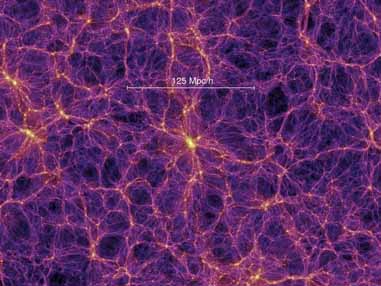 The conductor is plasma, which comprises 99.999% of the matter in the universe. Plasma is a state of matter in which electrons are not bound to a nucleus but flow freely. It can therefore conduct electricity.
The conductor is plasma, which comprises 99.999% of the matter in the universe. Plasma is a state of matter in which electrons are not bound to a nucleus but flow freely. It can therefore conduct electricity.
 The galaxies in our Universe are not uniformly distributed; most of them are drawn together in groups and clusters, with groups containing up to 50 galaxies and clusters up to several thousand. Those groups and clusters and additional isolated galaxies in turn form even larger structures called superclusters.
Superclusters are subordinate to enormous walls or sheets called "super cluster complexes", that can span a billion light-years in length, more than 5% of the observable universe. In 2006, scientists announced the discovery of three filaments aligned to form the largest structure known to humankind, composed of densely-packed galaxies and enormous blobs of gas known as Lyman alpha blobs.
The galaxies in our Universe are not uniformly distributed; most of them are drawn together in groups and clusters, with groups containing up to 50 galaxies and clusters up to several thousand. Those groups and clusters and additional isolated galaxies in turn form even larger structures called superclusters.
Superclusters are subordinate to enormous walls or sheets called "super cluster complexes", that can span a billion light-years in length, more than 5% of the observable universe. In 2006, scientists announced the discovery of three filaments aligned to form the largest structure known to humankind, composed of densely-packed galaxies and enormous blobs of gas known as Lyman alpha blobs.
Filaments, thread-like structures, are the largest known structures in the universe, that form the boundaries between large voids in the universe. They consist of gravitationally-bound galaxies; parts where a large number of galaxies are very close to each other are called superclusters. Beyond filaments there seems to be no continued structure in the organization of the large-scale structure of the universe.
For magnetic fields to pervade the universe electric currents need to flow. For currents to continue to flow, they must eventually form into circuits. We might imagine that the filaments shown represent cosmic size Birkeland Current circuits.
These images might remind us of the Oahspe images showing the Earth in Etherian worlds, swamps, mountains and roadways from the time of creation of the earth to the present (below).
Churchward writes:
In Psalms there is a reference 'before the mountains were raised ...
At the end of the Pliocene [5.332-1.806 million years BP], the earth went into final magnetic balance. Up to the beginning of the Pleistocene no mountains existed.
Two types of poleshifts are possible:
1) axial shift: a change in the inclination of the earth's spin axis caused by the entire planet altering its axial orientation in space (the position of the geographic poles and equator is unaffected)
2) polar wander: a change in the location of the geographic poles and equator caused by the entire earth, or its outer shell, moving relative to the spin axis, whose inclination remains unchanged.
When Oahspe says "the earth was turned from its axial course: the north becoming east, and the south becoming west" it refers to true polar wander.
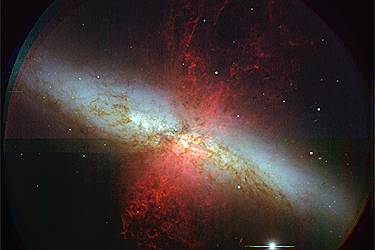
During the early 20th century space was thought to be a vacuum incapable of carrying electrical currents. But with the coming of satellite observations, the idea that the infinite resistance of empty space made it incapable of carrying current was no longer tenable. Today, the Plasma or Electric Theory is able to account for the dynamics and form of our manifested universe, with one principle to explain phenomena spanning scales ranging from sub atomic to super galactic. It depicts the universe as crisscrossed by vast electrical currents and powerful magnetic fields.
Plasma clouds that move relative to each other generate electric currents in each other. Electric currents in plasma take the form of twisted filament pairs, which follow the ambient magnetic field direction. The magnetic fields generated by these currents have been detected between and within galaxies. These currents are not visible because the current density is too low to excite the plasma to emit light. The current is in what plasma physicists call “dark current mode.”
Galaxies and the solar system are said to have formed from the gravitational collapse of a vast gas cloud. As this cloud contracted, it started spinning (like an ice skater who pulls in her arms). The problem with this theory is that centrifugal force of the cloud would have resisted further collapse, with the solar system stabilizing as a diffuse cloud of gas, roughly twice its present diameter. Gravity cannot carry away the angular momentum (spin) necessary to allow for further contraction.
If the sun had retained the angular momentum of the whole solar system it would now spin about once every 13 hrs. But it takes 50 times longer and has 2% of the solar system's angular momentum while Jupiter with only one thousandth the mass and Saturn have 97% (about 70% and 27% respectively).
The solar system presumably contracted from a proto-solar cloud about a light year in radius, roughly the distance between stars. Even if the cloud completed a rotation at the same rate as the galaxy (about once every 400 million years) it would have 700 times the angular momentum of the solar system today.
Even if, in the process of contraction, the central star had retained 2% of this angular momentum it would have stopped contracting at about a dozen times the size of the sun, far too big for a star. Its gas would be too cool and diffuse to burn hydrogen and Helium.
Therefore the solar system has to lose 99.9% of its initial angular momentum and transfer 98% of the remainder to the planets. This could be possible via electrical currents created by a protostar's magnetic field.
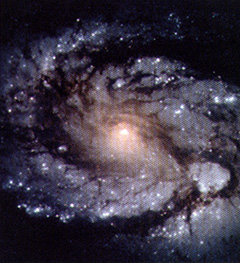
“The earth, the sun and many stars possess general magnetic fields. It is possible that spiral arms have regular magnetic fields, and that galaxies also have general magnetic fields ... it seems reasonably certain that interstellar matter is usually magnetized. This makes is likely that there should be some general process which produces magnetic fields in fluid bodies as different as the earth’s fluid interior, the stars, and interstellar matter. The energy required for magnetization can easily be drawn from the kinetic energy of internal motions, but the difficulty is to find a workable mechanism from the production of magnetic fields.”
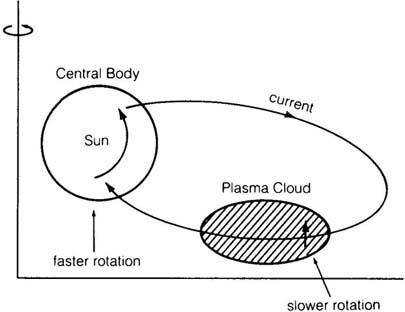
Alfvin theorised that a magnetic field rotating with the central body (Sun) sweeping through the surrounding clouds of plasma (that do not rotate as rapidly), will generate an electric current within them. This electrical current, because it is in a magnetic field, will exert a force that will cause the cloud to move in the direction of the magnetic field. Like the blades of a gigantic fan, the magnetic field transfers angular momentum from the central body to the cloud.
The resulting circuit will be a gigantic current carrying trillions of amps flowing out along the solar magnetic field lines through the cloud and back to the sun at its equator.
[Today, satellites have detected currents going from the sun, but as yet, not returning]
Just as the current flowing out to the cloud will accelerate its rotation, the current flowing in to the sun will slow its rotation. In this manner most of the angular momentum of the proto-solar cloud will be either transferred to the surrounding plasma, which will be flung outward or to the magnetic field itself, while much of the remainder will be transferred to the planets as they form smaller and denser plasma clouds.
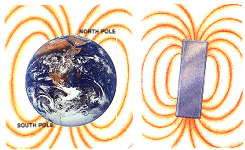
The theory of magnetohydrodynamics mathematically models plasma as magnetic fluid. One could then speculate that a vortex like the sun's could be a magnetic fluid of plasma.
MHD (see below) enables us to understand why magnetic field lines can be something other than the lines we see with a bar magnet and iron filings (right). In fact it is theorised that the sun's magnetic field during a solar cycle reveals that the dipolar lines of the sun's magnetic field during a solar minimum act like strands of thread that become twisted into rope that coils around the equator during the active solar maximum (believed to be due to the sun's differential rotation).
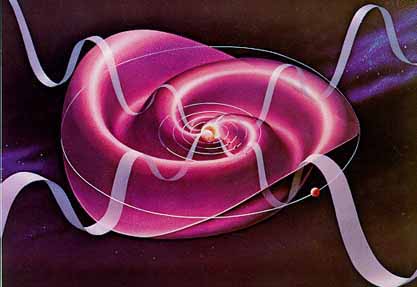 The heliospheric current sheet separates regions of the solar wind where the magnetic field points toward or away from the Sun. The complex field structure in the photosphere simplifies with increasing height in the corona until a single line separates the two polarities at about 2.5 solar radii. That line is drawn out by the radially accelerating solar wind to form a surface similar to the one shown in this idealized picture. The surface is curved because the underlying magnetic pattern rotates every 27 days with the Sun.
The heliospheric current sheet separates regions of the solar wind where the magnetic field points toward or away from the Sun. The complex field structure in the photosphere simplifies with increasing height in the corona until a single line separates the two polarities at about 2.5 solar radii. That line is drawn out by the radially accelerating solar wind to form a surface similar to the one shown in this idealized picture. The surface is curved because the underlying magnetic pattern rotates every 27 days with the Sun.
A charged particle can move along a magnetic field line of force without experiencing resistance, but if it tries to cross the lines a secondary magnetic field is introduced. The resulting force opposes the direction of motion. Thus, flow of ionised material tends to take place along the imaginary lines of force of the local magnetic field. Matter and fields are coupled together or "frozen in", moving exactly as the plasma does.
Waves in plasma simulaneously create waves of magnetic field direction.
Depending on relative energies in the plasma and the magnetic field, plasma is forced to move along the magnetic field lines (as in a sun's prominence, where the field is dominant and matter flow is governed by the field,) or the magnetic field is dragged along by the plasma (as in the heliosphere and magnetosphere, where the kinetic energy is dominant, making the field lines distorted,).
Propagating plasma waves (MHD) are also called Alfven waves (after their discoverer and founder of Plasma Cosmology).
MHD is to assumed to be a fluid that is a perfect conductor with little or no resistivity; this simplification is called ideal MHD. In ideal MHD, Lenz's law dictates that magnetic field lines cannot move through the fluid, instead remaining attached to the same small piece of fluid at all times. Under such conditions, most electric currents tend to be compressed into thin, nearly-two-dimensional ribbons termed current sheets. This has the effect of dividing the fluid into magnetic domains, each of which may carry a small electric current in the direction of the magnetic field lines themselves, with most current contained in current sheets between the domains.
The connection between magnetic field lines and fluid in ideal MHD fixes the topology of the magnetic field in the fluid -- for example, if a set of magnetic field lines are tied into a knot, then they will remain so as long as the fluid/plasma has negligible resistivity. This difficulty in reconnecting magnetic field lines makes it possible to store energy by moving the fluid or the source of the magnetic field. The energy can then become available if the conditions for ideal MHD break down, allowing magnetic reconnection that releases the stored energy from the magnetic field.
There are few perfect conductors. Physical systems have some non-ideal behavior.
The magnetic field can generally move through the plasma, following a diffusion law with the resistivity of the plasma serving as a diffusion constant. This means that solutions to the ideal MHD equations are only applicable for a limited time before diffusion becomes dominant. Solar active regions have diffusion times of hundreds to thousands of years, much longer than the actual lifetime of a sunspot -- so they can be treated as ideal MHD systems.
Under ideal MHD, all "sheets" of current are infinitely thin and have infinitely high current density. In reality, the thickness of a current sheet is limited both by the resistivity and density of the plasma. Current sheets in the solar corona are thought to be between a few meters and a few kilometers in thickness, which is quite thin compared to the magnetic domains (which are thousands to hundreds of thousands of kilometers across).
Alfvén described MHD as a "magnetic field description" and applied an "electric current description" to plasmas such as Birkeland currents (field-align currents), double layers (charge separation regions), certain classes of plasma instabilities, and chemical separation in space plasmas.
The structure of the Interplanetary Magnetic Field (IMF) is determined by the coronal expansion. The magnetic field frozen in the matter is dragged with it in its radial expansion. Because of the sun's rotation, the magnetic field's force lines, rooted in the solar corona, form an Archimedes spiral around the sun.
Polar coronal holes evolve and deform, causing the neutral sheet to undulate like the skirt of a pirouetting ballerina. At the solar minimum the depth of the waves is +/- 15 degrees of latitude. Because of these undulations the neutral sheet crosses the equatorial plane in several places thereby dividing the equatorial region into sectors with alternating polarity.
The solar wind is also governed by MHD. The differential solar rotation may be the long term effect of magnetic drag at the poles of the Sun, an MHD phenomenon due to the Parker spiral shape assumed by the extended magnetic field of the Sun.
Previously, theories describing the creation of the Sun and planets could not explain how the Sun has 99% of the mass, yet only 1% of the angular momentum in the solar system. In a closed system such as the cloud of gas and dust from which the Sun was formed, mass and angular momentum are both conserved. That conservation would imply that as the mass concentrated in the center of the cloud to form the Sun, it would spin up, much like a skater pulling their arms in. The high speed of rotation predicted by early theories would have flung the proto-Sun apart before it could have formed. However, magnetohydrodynamic effects transfer the Sun's angular momentum into the outer solar system, slowing its rotation.
Breakdown of ideal MHD (in the form of magnetic reconnection) is known to be the cause of solar flares, the largest explosions in the solar system. The magnetic field in a solar active region over a sunspot can become quite stressed over time, storing energy that is released suddenly as a burst of motion, X-rays, and radiation when the main current sheet collapses, reconnecting the field.
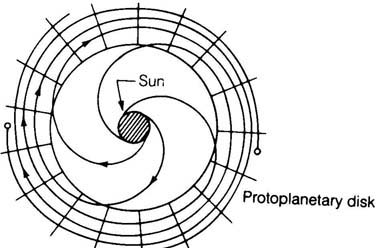
Alfven tried to apply MHD waves to solve the question of how currents can transfer angular momentum in a developing solar system, but the magnetic field as theorised would be too weak and unstable. If the currents around the sun and their associated magnetic fields were evenly spread out they would be wound up by the solar system plasma and be too weak to accelerate the gas cloud's plasma, eventually becoming circular and thus incapable of transferring momentum from the sun.
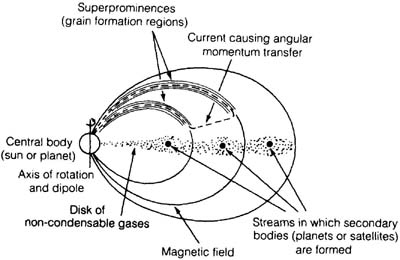
But if the currents were concentrated into force free 'super prominences', they could push the plasma around without the plasma getting wound up itself, and start the process of forming planets by pinching plasma together. Their concentrated magnetic fields would transfer angular momentum efficiently and the filaments themselves would roll through the plasma without being unstable, as a dispersed field would.
Without vortices the magnetic field in which the galaxy rotates will be 'frozen into' the galaxy's motion, its patterns disrupted; the galaxy won't lose angular momentum to contract and form stars. The vortices allow the galaxy to roll through the background field, generating in the process, energy (it needed to lose) to slow it down and the pinch needed to form stars.
The "freezing" of magnetic fields in a plasma was rejected by Alfvén after his initial contributions to the field of MHD. He realised that plasma in space is an excellent conductor but it is not a superconductor, as astronomers assume when they talk of ‘frozen in’ magnetic fields. A frozen-in field implies no voltage differential in a plasma, and therefore no electric current. He even mentioned this misconception (which is in the textbooks nowadays) in his speech when he received his Nobel award. The magneto-hydrodynamics theory is today useable, though it's basic assumptions are incorrect. It still fits the standard model.
Acording to the following news dated July 15 2003 gravity doesn't always do what scientists expect (if it exists at all!).
Galaxies like our own Milky Way have about 100 billion stars. But a small minority of galaxies are bloated and full of gas; gas that should have turned into stars. About 20 nearby galaxies were the most extreme examples known of this phenomenon. These galaxies are a mystery to astronomers. Most galaxies transformed gas into stars but these galaxies have held back its not known why. There is enough left-over hydrogen gas in our galaxy to form 50 billion stars - that is, an amount equal to half the actual number of stars. By contrast, the gassy galaxies had 10 times more hydrogen gas than stars.
[Plasma Cosmology Part 3 ]
[The Sun Part 4 ]
[Part 5 ]
[Part 6 ]
[The Magnetosphere Part 7]
[Bits and Pieces Part 8]
[Cosmogony and Pseudo-Science]
Some of my other websites
Galactic Alignment
Encounter with Dr Kimura, and the 'Underwater Pyramid
Identifying Pan, the Submerged Continent
Home Page
Please email me